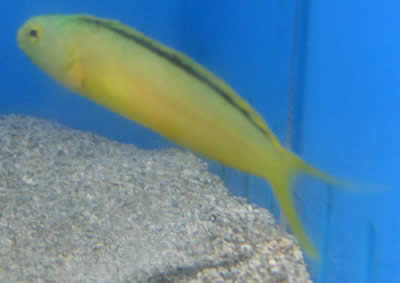Blenny_canary
Canary Fang Blenny, Green Canary Blenny, Qualan Forktail Blenny Scientific Name: Meiacanthus oualanensis
Wed, 16th July, 2025 - 10:58 pm GMT
Sponsor Ads:

Alternative Name
Canary Fang Blenny, Green Canary Blenny, Qualan Forktail Blenny Scientific Name: Meiacanthus oualanensisBasic Info
The Canary Blenny reaches about 4 inches (10 centimeters) in length at maturity. It has two small, protruding, pointed canine teeth, which give it a fanged appearance. These teeth are associated with venom glands. As its name suggests, Canary Blennies are usually a bright canary yellow color. They have elongated slender bodies and an elongated tail.
Health
A single Canary Blenny should have a 25 gallon sized aquarium or larger. Temperatures between 75 and 78 degrees Fahrenheit (24 to 26 degrees Celsius) are appropriate. The pH value should remain between 8.3 and 8.4. A specific gravity between 1.020 and 1.025 will work nicely for a Canary Blenny. In a fish-only enclosure, the specific gravity should be in the lower end of this range (below 1.023); however, in aquariums containing invertebrates, the upper range, between 1.023 and 1.025, would be necessary for the maintenance of those animals. Introducing Canary Blennies to well-established aquariums containing live rock has the advantage of allowing them to graze on plant material. Breeding Canary Blennies usually reproduce in pairs. Males often change color quickly at breeding season, and are larger than females. Captive breeding is not widely accomplished.Habitat
Saltwater FishBehavior
The Canary Blenny can make a wonderful addition to many community or reef aquariums. With their relatively peaceful natures and their brilliant colorings, these Blennies can make interesting captives. In the wild, Canary Blennies graze and feed on plankton. They are equipped with a pair of venomous fangs, which they usually use as a defensive measure against predation. These fangs can (and often do) deliver a painful bite, and it is advisable to avoid reaching into your Blenny's aquarium or hand feeding it. Canary Blennies are considered to be reef safe. They normally do well in community environments as long as plenty of space and hiding places are provided. However, they normally do not get on well with other Canary Blennies, and unless you are attempting to create a mated pair, it is advisable to keep only one of these fish per aquarium. One of the most charming traits of the Canary Blenny is its apparent boldness; these fish seem to spend little time hiding and often swim in open areas. Their bright, usually yellow, color can really add interest to an aquarium. Often, Canary Blennies are added to aquariums containing live rock. This allows them the opportunity to perform the natural grazing behavior they would show in the wild, and the material they glean from this rock provides an important part of the Canary Blenny's diet.Origin
Indo-PacificHistory
Canary Blennies are generally collected from the tropical Pacific Ocean. Because other Blenny species are known as Canary Blennies, it is important to mention the scientific name of the species you are referring to, in order to avoid confusion.Common Foods
Normally, Canary Blennies are maintained on a variety of chopped meat and vegetable foods, including plankton, mysis shrimp, brine shrimp, or other crustaceans.Sponsor Ads:
Under the most rigorously controlled conditions of temperature, pressure, humidity, time, and voltage, the machine will do as it damned well pleases. -- Unknown
Blenny_canary
Coded by: BGID® | ALL RIGHTS RESERVED Copyright © 2000-2025
Disclaimer | Privacy | Report Errors / Contact | Credits








 Why haven't we as a collective earth met with aliens yet?
Why haven't we as a collective earth met with aliens yet?  World EcoSystem - Biodiversity Changes - Who is on board and who isn
World EcoSystem - Biodiversity Changes - Who is on board and who isn  Homosexual behavior stems from the mind or genetics?
Homosexual behavior stems from the mind or genetics?  The Best Text Adventure You Will Ever Play! The official site:
The Best Text Adventure You Will Ever Play! The official site:  Mouthwash - Mouthrinse - Mouth Sores - Healing Infections - Gingivitis
Mouthwash - Mouthrinse - Mouth Sores - Healing Infections - Gingivitis  Treatment for Depression
Treatment for Depression  Ultra radical and violent Islamist group that even rivals Al Qaeda
Ultra radical and violent Islamist group that even rivals Al Qaeda  An idea to have teachers who want to carry guns to school undergo some level of police training will be left up to local school districts and police departments.
An idea to have teachers who want to carry guns to school undergo some level of police training will be left up to local school districts and police departments.